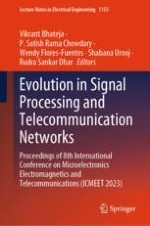2024 | Buch
Evolution in Signal Processing and Telecommunication Networks
Proceedings of 8th International Conference on Microelectronics Electromagnetics and Telecommunications (ICMEET 2023)
herausgegeben von: Vikrant Bhateja, P. Satish Rama Chowdary, Wendy Flores-Fuentes, Shabana Urooj, Rudra Sankar Dhar
Verlag: Springer Nature Singapore
Buchreihe : Lecture Notes in Electrical Engineering
